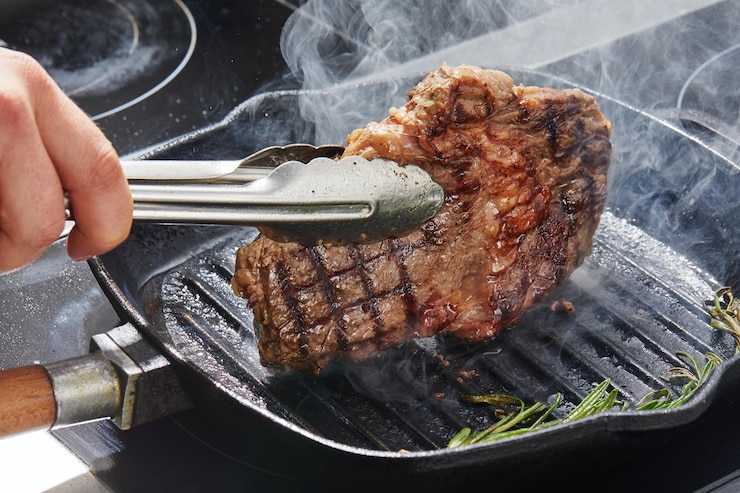Learning how to cook steak is one of the most fulfilling culinary accomplishments in the context of home cooking. It’s the type of dish that carries emotional weight, whether it’s grilled during summer vacations, served at anniversaries, or thinly sliced for a peaceful weekday treat. The road to the ideal steak isn’t complicated, though. Heat, butter, and a little self-control are the first ingredients.
With just a stovetop pan and three basic ingredients—butter, garlic, and thyme—you can make an incredibly delicious steak that can compete with those found in upscale dining establishments. These ingredients create a golden elixir that adheres to the meat when basted continuously, significantly improving the flavor and crust. In practice, what appears modest can be incredibly transformative.
Steak Cooking Technique – WordPress Table Format
| Step | Details |
|---|---|
| Bring to Room Temp | Ensures even cooking from edge to center—especially critical for thicker steaks |
| Pat Dry & Season | Preps the surface for a proper sear and helps salt penetrate the meat |
| Use a Smoking Hot Pan | A cast iron or heavy-bottom skillet maximizes crust via the Maillard reaction |
| Add Butter & Herbs | Once flipped, add butter, garlic, and thyme—then baste the steak continuously for rich flavor infusion |
| Monitor Internal Temp | Use a thermometer and remove the steak just before your desired doneness; it will continue to cook while resting |
| Let It Rest | Allow 5–10 minutes before slicing—this step helps redistribute juices, leading to a moist final cut |
Keeping Things Simple: Timing, Texture, and Temperature
Every chef will tell you that control, not ingredients, is the key to successful steak cooking. You can achieve more evenly cooked meat by bringing your cut to room temperature in advance, which greatly lessens the internal shock caused by heat. It’s a subtle yet remarkably powerful adjustment that distinguishes novice endeavors from professional outcomes.
Controlling moisture is equally important. A steak sears better when it is dry. In addition to adding flavor, patting it down and liberally seasoning it with salt and pepper prepares the surface for the incredibly satisfying crust that forms in the first two minutes on a screaming hot pan.
The Pan Baste: An Important Ritual to Learn
After the initial flip, adding butter and aromatics elevates the steak rather than merely finishing it. The act of repeatedly spooning hot, herb-infused butter over the meat may appear theatrical, but it serves a very practical purpose.
The essential oils of the garlic and thyme are released into the butter as they brown and crackle. These compounds seep into every nook and cranny of the steak when spooned over it. The end effect is a complex, powerful, and incredibly subtle flavor. This fat-rich baste works especially well to restore mouthfeel to leaner cuts.
Time Is Everything: The Fine Art of Doneness
It takes deliberate timing, not a lot of guesswork, to reach your desired level of doneness. To avoid overcooking, remove the steak a few degrees early and use the remaining heat to finish the job. The distinction between sublime and just fine can be made by this carryover effect, which is particularly apparent in thicker steaks.
| Doneness | Target Internal Temp (°C) | Remove At (°C) |
|---|---|---|
| Rare | 50 | 47 |
| Medium Rare | 55 | 52 |
| Medium | 60 | 57 |
| Medium Well | 65 | 62 |
| Well Done | 70 | 67 |
Building the Plate: Star-Framing Pairings
After your steak has finished cooking and rested, it’s time to add sides that complement its flavor. Paris Mash is a silkier, more opulent version of mashed potatoes that goes very well with the steak’s crusty exterior for a decadent experience.
Are you trying to find something lighter? Garlic-sautéed spinach or roasted broccoli provide a bright, green contrast and are incredibly quick to prepare. Crispy mashed potatoes offer crunch, and cauliflower cheese offers creamy comfort without being overbearing, if you’re looking for variety.
Steamed green beans or creamy cauliflower mash provide flavor without being heavy for those watching their carb intake. These side dishes carefully complement your steak rather than overshadow it.
Why Technique Is Better Than Tools
A steak’s technique, purpose, and timing are what really make it memorable, not the quality of the beef or the pan you use. Surprisingly, this technique doesn’t call for an elaborate sous-vide setup or a backyard grill. It just requires heat, patience, and faith in your method.
Learning to cook steak this way becomes more than just a recipe; it becomes a personal ritual in the context of daily meals. One that arouses pride in addition to hunger. One that turns a typical evening into something to be treasured.
Perhaps most significantly, it serves as a reminder that culinary excellence need not always equate to luxury. Sometimes it’s important to go back to the basics. You’re doing more than just cooking when you have butter bubbling in the pan and thyme dancing in the air. Bite by bit, you’re crafting something that will be remembered.

